Serving the Last Generation of Holocaust Survivors in New York
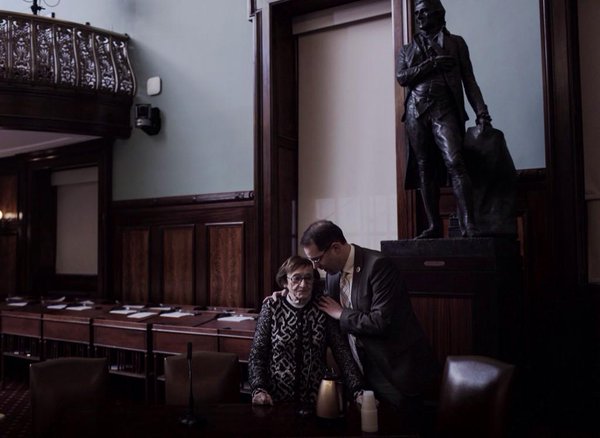
Mrs. Klein, a Holocaust survivor, with Council Member Levine (William Alatriste)
“If our stories do not survive when we are gone, then six million Jews were murdered in vain.” That sobering call to action from Mrs. Klein, one of the 4,700 Holocaust survivors served by Selfhelp Community Services each year, rings especially true as we marked Yom HaShoah, the annual commemoration of Jewish survival through last century’s great tragedy.
At this time of the year, we are once again reminded to share the stories of the past to prevent atrocities of this kind from happening again. The time to share the memories and lives of the remaining survivors is fleeting. This is the last generation of Holocaust survivors – a sad fact that is painfully real.
To pass these stories to the next generation, Selfhelp recently concluded seven performances of Witness Theater, a program that Selfhelp brought to New York, with the support of UJA-Federation of New York, the Jewish Communal Fund, and the Conference on Jewish Material Claims Against Germany. Now in its fourth year, the program utilizes drama therapy as a vehicle through which high school students work with local Holocaust survivors to re-enact critical moments from the survivors’ lives, creating a moving and educational performance to share with fellow students, parents and the community.
As I watched the survivors on stage, it was hard not to notice how time is taking its toll. A small twitch in their hand, their walkers and canes, and the assistance they need from the students to move across the stage, all remind us how much support they need. And as this last generation grows older, their needs become more intense, more costly.
New York is home to more than half of the approximately 110,000 Holocaust survivors living in the U.S., with the majority residing in New York City, Long Island, and Westchester. Of the 55,000 survivors living in New York City, about half live at or below the poverty line. Many of them lack the means for even the most basic necessities, including proper housing and health care, and they live on fixed incomes that do not accommodate escalating food prices, water and utility bills, the cost of medications, and other vital supports. Niceties such as a show, a new dress, a visit to the museum are unimaginable when rent must first be paid.
The circumstances under which many Holocaust survivors live, along with the nature of the challenges they confront as they age, require special attention. Normal aging is complicated by unique problems not generally experienced by elderly persons. They have brittle bones and serious dental problems caused by malnutrition and stress experienced during their youth and early childhood. Traumas of dislocation, as well as the loss of loved ones and communities, can cause sleep disturbance, anxiety, depression, or an inability to trust. Some survivors may keep food nearby at all times. Others may bathe or permit sponge baths, but will not take a shower.
To address the needs of this population, the New York City Council created the Holocaust Survivor Initiative last year, with the leadership of Speaker Melissa Mark-Viverito and Council Members Rafael Espinal, David Greenfield, and Mark Levine. This $1.5 million allocation supported 11 non-profits around the city to provide case assistance, socialization programs, and entitlements and benefits enrollment to the 55,000 Holocaust survivors living in New York City.
These city funds helped Selfhelp to serve almost 300 low-income survivors with case assistance. Our social workers helped clients enroll in a range of benefits and entitlements, such as Medicare and Medicaid, rental and nutritional assistance, and Meals-on-Wheels. In just one fiscal year, we conducted a total of 343 home visits and provided almost 1900 hours of case management. The funding allowed our staff to help clients access and save close to $1.5 million. When more than half of the city’s survivors live at or below the poverty line, the money they save goes straight towards food, medication, and rent.
Two years ago, Selfhelp testified at a U.S. Senate hearing on the needs of Holocaust survivors. At that hearing, Senator Bill Nelson, the chair of the U.S. Senate Special Committee on Aging, noted, “I am proud that the United States has a legacy of caring for the needs of aging Holocaust survivors. But, we must recognize that the demand for care is still there – and only becoming more challenging.”
I am so grateful that our leaders on the city, state, and federal levels of government have raised the needs of this population and started to allocate funding. However, as Senator Nelson noted, the demand for care is increasing, and an increased investment is needed.
Our elected officials often remark that a budget is a statement of priorities. With about 30,000 survivors living at or near the poverty line, struggling to get by, one of our city’s top priorities should be caring for our survivors and providing assistance so they can age with dignity, independence, and the support they need.
***
Stuart C. Kaplan is CEO of Selfhelp Community Services. On Twitter @selfhelpny.
***
Have an op-ed idea or submission for Gotham Gazette? Email This email address is being protected from spambots. You need JavaScript enabled to view it.
City Should Call an Eviction Moratorium
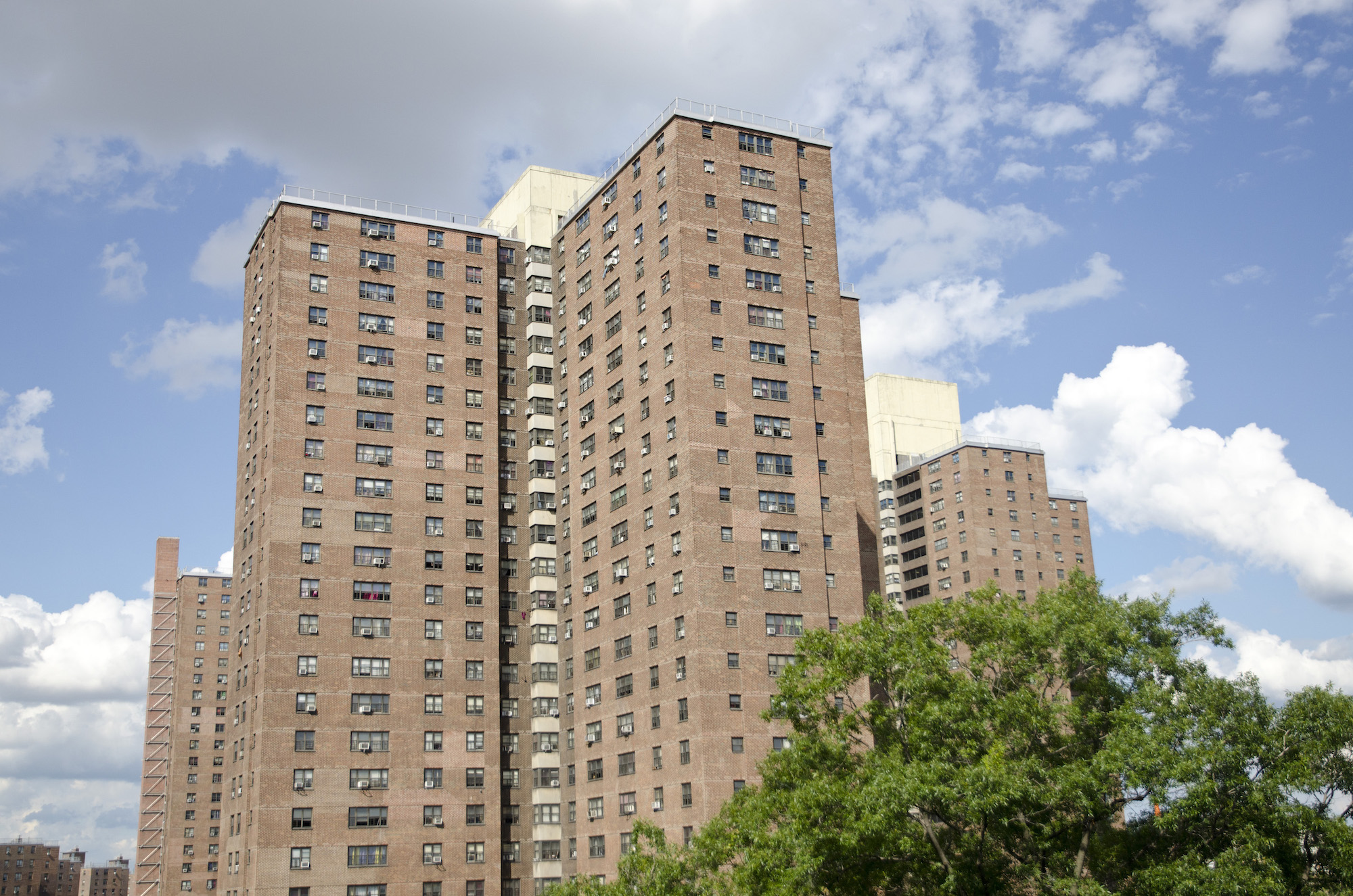
photo: Edward Blake via Flickr
One fear that is prevalent in every borough of New York City is the threat of eviction. Gentrification and the ever increasing housing affordability gap makes staying in an apartment harder and harder each year for thousands of tenants. Evictions are handed down in Housing Court, where the odds do not favor low-income tenants.
As of 2015, an estimated 90 percent of these tenants go through Housing Court without legal representation. In attempts to combat this, the New York City government has provided millions in funding to legal advocacy organizations to defend tenants in Housing Court and prevent evictions. As a result, New York saw an encouraging 18% decrease in the number of evictions in 2015 due to the increase in assistance of legal services. While this additional funding is making strides in helping combat high eviction rates, these efforts are not doing enough.
In order to provide real assistance and protection to its low-income residents and tenants as well as reduce racial discrimination, New York City should call for an indefinite temporary moratorium on evictions.
In September of 2015, I began work as a legal intern at the Safety Net Project at Urban Justice Center. For nine months straight, I spent hours at Bronx Housing Court with hundreds of tenants, conducting intakes for potential clients for the attorneys to represent in Housing Court. During this time, I realized that one way to address the housing and eviction crisis in New York City could be a temporary moratorium on evictions.
In a city plagued with homelessness, a poverty crisis, and drastic rates of gentrification, by instituting an eviction moratorium city government would not only be assisting its low-income residents, but also relieving its overburdened court system and the organizations trying to help tenants.
A moratorium on evictions, while it sounds extreme and improbable, would actually be quite feasible and beneficial.
Landlords, while not being able to evict tenants, would still be able to collect money settlements. This could take place in Small-Claims, Civil, or even the Supreme Court. During this indeterminate period, New York would be able to reevaluate its current housing crisis and come up with better multi-faceted solutions while thousands would not be threatened with homelessness.
The city, not burdened with the cost of both evictions and rising shelter expenses, could shift its focus and funding to other programs such as new or increased housing subsidies. Because of the inadequate number of affordable apartments, new and additional subsidies would allow access to a wider population of New Yorkers, thus diminishing the homeless population. This would result in annual savings at shelters throughout the city as well.
Housing Court and evictions demonstrate not only injustice against low-income tenants, but also racial discrimination. If you walk into Housing Court in Brooklyn, the Bronx, Manhattan, Queens, or Staten Island, you see clearly that the majority of tenants are people of color. Approximately seven of every ten clients I spoke to at Housing Court were African-American women. This opens up an even wider conversation about discrimination based on race and gender where black men are locked up and black women are locked out. An eviction moratorium would potentially limit these racially discriminatory practices.
Various types of moratoriums have actually taken place all across the country and yielded positive results.
In Salt Lake City, a one-year impact fee moratorium was imposed to help reassess the dysfunctional collection fee system. Recently, Oakland, California approved a 90-day freeze on rent hikes and an eviction moratorium to help the city deal with its ever-growing housing crisis. Chicago instituted an official annual moratorium on evictions from December 18 through January 5 to give tenants a holiday reprieve. This moratorium is also in effect when temperatures reach 15 degrees or colder or when severe weather conditions would make it dangerous to evict tenants. Moratoriums like these give cities time - opportunity to assess, reevaluate, and change any facet of policy that negatively affects tenants, recognizing that housing is a basic right and essential to pursuing other aspects of life. New York should be able to institute something similar.
Currently, the only existing eviction moratorium in place is the annual and informal practice conducted by marshals, who typically cease all evictions during the Christmas holiday into the new year. However, while this practice is neither sanctioned nor uniformly widespread, it does not address the larger issue of the vast number of low-income New Yorkers who are displaced from their housing each year. Another eviction moratorium, an official one, took place in 2012 after Hurricane Sandy. While no formal statistics could be found to show the benefits of these moratoriums, both led to more tenants in housing and reduced costs to the city for expenses like shelters.
In the fast-paced City of New York, tenants have seen rapid gentrification, judges pushing for settlements instead of fair decisions, and landlords seeking quick evictions. A moratorium on evictions would effectively slow down this process, keep people in their homes, provide more subsidies to put more people into new homes who currently do not qualify, and save the city money.
Lastly, New York stands as a beacon of change on many issues. Evictions are a national epidemic. A New York eviction moratorium would act as an example for the rest of the country, thus leading to fewer homeless Americans across the country. It should not take the Christmas spirit or a devastating hurricane to call the city to act in defense of its most vulnerable residents. A housing disaster is already taking place.
***
Tyler Tagliaferro is a double major in Political Science and American Studies at Fordham University.
***
Have an op-ed idea or submission for Gotham Gazette? Email This email address is being protected from spambots. You need JavaScript enabled to view it.
A Budget for the City of Immigrants
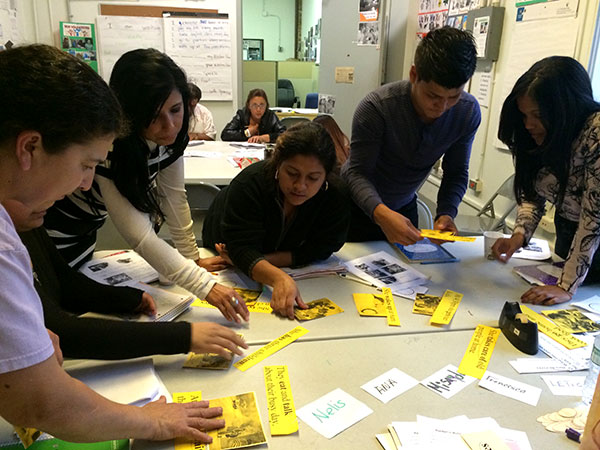
Students of an adult literacy class (photo: Make the Road New York)
In recent years, New York City has taken major strides forward in its engagement with immigrant communities. Under the leadership of Mayor Bill de Blasio, City Council Speaker Melissa Mark-Viverito, and the Council as a whole, our city has adopted and invested in new initiatives to welcome and protect immigrants and embrace their tremendous economic, cultural, and political contributions.
Now, with the 2017 budget process in final negotiations, our leaders have a key opportunity to further address the barriers to opportunity and equity that immigrant communities continue to face. That’s why today, five leading immigrant organizations are releasing a new report, “A Budget for the City of Immigrants,” which identifies key policy areas in which immigrant communities need further investment.
Despite path-breaking initiatives like IDNYC (the municipal identification card program), ActionNYC (one of the nation’s first large-scale municipal navigation and outreach programs to connect people to free immigration legal screenings), and the New York Immigrant Family Unity Project (the nation’s first program to guarantee counsel to low-income immigrants facing deportation), immigrants still face enormous challenges in accessing public services, getting the support to succeed in the workforce, and being informed of their rights.
The new report highlights key priorities across various issue areas, ranging from adult education to youth programs to health care access, but a few priorities bear particular mention.
First, our City must expand its investment in adult literacy to a baselined $16 million per year.
Adult newcomers who have come here to work and support their families often struggle with limited English proficiency (LEP). Despite enormous demand for adult literacy classes, supply has lagged—less than three percent of those in need can access community-based adult education programs. A recent Make the Road New York and Center for Popular Democracy report, “Teaching Toward Equity: The Importance of English Classes to Reducing Economic Inequality in New York,” highlights how meeting the language needs of LEP New Yorkers would both further immigrant integration and generate billions of dollars in new earnings. New York City can lead again by making sure that adult immigrants can learn English and develop the tools they need to thrive.
Second, our city must direct $13.5 million for immigration legal services for complex cases.
Currently, New York City provides few resources for complex immigration legal cases where an individual is facing imminent deportation yet cannot be served under most existing funding streams. This leaves thousands of immigrants on waiting lists. A survey by the New York Immigration Coalition of the city's legal services providers noted that 60% of immigrants seeking their services had complex cases that need intensive representation. Further resources must focus on these complex immigration cases—especially for families who are on the verge of being torn apart without adequate legal representation.
Third, our city must expand its investment in Access Health NYC to $5 million.
This new City Council initiative has shown tremendous promise by working with community organizations like the Coalition for Asian American Children and Families to educate immigrants about health care options and enroll them for coverage, wherever possible. Health care access is another area where our city has shown leadership, and it should expand its commitment in this budget year.
Fourth, our city must move forward with the investment of $868 million in capital funding for the construction of new classrooms and schools to combat overcrowding and pursue additional means to meet the more than 100,000 school seats needed citywide.
The 2017 budget must include strong investment to address this widespread problem, while our leaders explore further action in future years to fix it once and for all.
Finally, New York City must take further steps to strengthen the landscape of grassroots, immigrant-led nonprofit organizations that are the backbone of our communities yet often struggle, as the Asian American Federation and the Federation of Protestant Welfare Agencies have noted, to operate on a level playing field with larger organizations.
By increasing the Nonprofit Stabilization Fund to $5 million and amending municipal contracting policies to open new opportunities for these smaller organizations, the city can go a long way to strengthening immigrant communities as well.
The priorities outlined in A Budget for the City of Immigrants, of which these are just a few, show concrete opportunities to consolidate the progress our city has made with respect to immigrant communities and ensure that we continue to move forward. With immigrant communities at the heart of our global city, we must use this budget cycle to continue to lead the way in welcoming and protecting immigrants.
What is good for immigrant communities is good for New York City, the city of immigrants.
***
Javier H. Valdés is the Co-Executive Director of Make the Road New York. Steve Choi is the Executive Director of the New York Immigration Coalition. On Twitter: @MaketheRoadNY & @thenyic.
***
Have an op-ed idea or submission for Gotham Gazette? Email This email address is being protected from spambots. You need JavaScript enabled to view it.
Misguided 'Reform' Threatens to Undo Progress
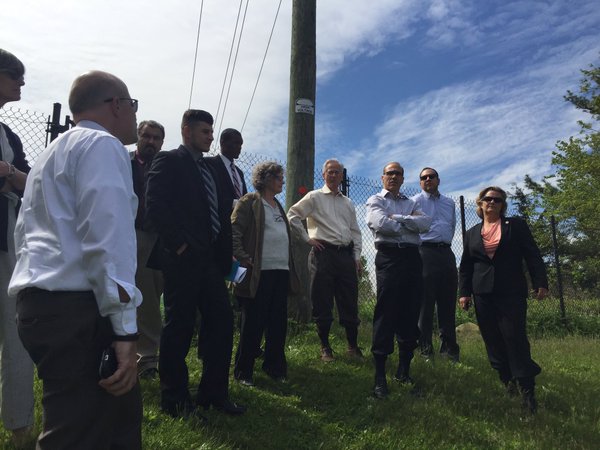
BP Oddo, the author, with a group on Staten Island (photo via @StatenIslUSA)
The divide is even greater than I feared.
The chasm between how folks across this city see our world is even wider than what it seemed. As a Republican fully aware he’s in a blue city - a guy who once led a merry band of between two and five GOPers in a legislative body of 51 - I know better than most how disparate the various points on the political spectrum are in this town, and how the perceptions, reality, and everyday feel differs across New York City.
I lived that divide and operated within it when I was in the City Council. And to deliver for the smallest, least politically influential borough, one that was either ignored, neglected, or treated as fifth of five except during the Giuliani years, I figured out how to respect the divide, maneuver within it, and effectively represent my community.
So when I say the breach is even more expansive than I once feared, it truly is.
The City Council’s Criminal Justice Reform Act is intended to help New Yorkers represented by a majority of the City Council. It’s intended to address problems that are real to them and their constituents. With that said, to folks who live on Staten Island like me, and those in other areas such as Southwest Brooklyn, parts of Queens, and parts of the Bronx, this package represents a chainsaw where a scalpel is needed. We should not be encouraging people to think we don’t care about negative behavior like urinating in public or throwing trash on the ground.
Ultimately, the bills are Miracle Grow for the perception that lawlessness lurks around the next corner, a perception that we know can feel awfully similar to reality. A furthering of this ideological agenda corrosively eats away at the thin line between civilized communities and disorder.
For the love of Pete (not Pete Vallone Jr. or Sr., but man, where have you guys gone...), can’t we even agree in this town that litter is wrong and should be punished as often and in as financially impactful a manner as possible? One unified voice coming from the Council and other sectors of city government should be all of us saying to the city agencies that the guy who throws the bag of White Castle burger remnants out the window of his car and the mocha latte drinker who flings her empty plastic cup indiscriminately into a street should pay dearly.
But we can’t even agree on that. As someone who has spent too much time, energy, and taxpayer money these last 28 months as Borough President trying to change the behavior of the selfish, ignorant Staten Islanders who continue to litter, that hurts my head.
I am keenly aware that in many ways - from home and car ownership percentages to housing typology and various other barometers - Staten Island more closely resembles the rest of America than the other four boroughs. I understand this is a left-of-center town during this “progressive” era of local government, but some truths are grounded in history and history should not need to repeat itself for us to understand the consequences of actions like passing the Criminal Justice Reform Act. So-called quality-of-life offenses rob residents of the city they deserve and expect. As a city we should be doing more to discourage litterers and those engaged in public urination and other anti-social acts on behalf of the overwhelming majority of New Yorkers who don’t engage in these behaviors.
Whether folks liked or disliked Rudy Giuliani, his unquestioned, greatest and lasting legacy is that every New Yorker now has a heightened expectation of how safe and orderly New York City should be. Individually and collectively we will never tolerate a return to the “bad old days.” I am not one who embraces the screaming tabloid headlines announcing the 1970s have returned. That’s silly. I simply don’t like seeing perhaps well-intentioned, but nonetheless misguided steps, even small ones, in that direction.
***
James Oddo is the Staten Island Borough President and a former Minority Leader of the City Council. On Twitter @HeyNowJO.
***
Have an op-ed idea or submission for Gotham Gazette? Email This email address is being protected from spambots. You need JavaScript enabled to view it.
Home Care Workers Need a Dedicated Advocate
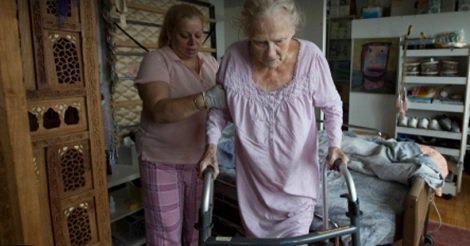
photo via PHI
Nearly 175,000 New York City residents go to work each day in the homes of New Yorkers who are elderly or living with disabilities. Predominantly immigrant women of color, these aides assist with personal care, medications and other health-related tasks, meals, housekeeping, and a variety of other activities. They are crucial to keeping people who are frail or suffering from chronic illnesses healthy, safe, and independent. They have become vital to system reform efforts intended to improve the health of New Yorkers while also reducing costly and unnecessary visits to emergency rooms.
Home care workers, who may be home health aides or personal care aides, comprise the single largest occupational group in New York City. Nonetheless, they have a long history of marginalization: poverty-level wages, lack of standard labor protections, part-time hours, insufficient training and support on the job. That situation is beginning to change as policymakers recognize that the city faces a potential care crisis: a rapidly growing older population that requires a stable, skilled workforce to provide home care services.
Over the past five years, a raft of new federal, state, and local regulations - Wage Parity for personal care and home health aides, Domestic Workers Bill of Rights, and expansion of Fair Labor Standards Act to include home care aides - have been put in place to raise wages and improve working conditions. In addition, home care aides are affected by the rising minimum wage and new paid leave regulations. These measures are critical to improving the quality of home care jobs and attracting new workers, but they also have created a level of complexity that makes it difficult for employers to comply and for workers to know their rights.
The Wage Parity law requires that a home care aide be paid $10 per hour during the time she is with her client. She is paid minimum wage, currently $9 an hour, for travel time between clients. If her total number of weekly hours, including travel, is 45 hours, she must be paid time-and-a-half on her base wage for the hours over 40. The employer must calculate the base wage using a formula that accounts for hours worked ($10/hour) and paid travel time ($9/hour). How is this worker able to determine if she is being paid the right amount? What if she has an overnight shift? For how many hours should she be paid, and at what wage?
Both employers and home care aides need an unbiased source of information and assistance to navigate these rules and regulations. That is why PHI supports the proposal to include a Division of Paid Care, with a public advocate devoted to supporting the home care and day care workforces, in the new city Office of Labor Standards. For New York City’s home care workforce, this office could offer several crucial services:
Education: Assist home care workers and their employers in learning about labor laws and regulations. For example, the advocate could spearhead public education on rules regarding compensation and labor protections. The advocate would also be available via a toll-free number to answer any questions workers had about their rights.
Tracking and Reporting: Create a system for reporting complaints, cataloguing questions, and providing timely answers to frequently asked questions. An effective system would provide workers with a supportive environment in which to learn about their rights and file a complaint, if warranted. The advocate could track complaints and issue an annual report describing type and frequency, and propose appropriate measures to reduce violations.
Assistance and Support: Help workers access state and local services for low-wage workers - for example, connecting workers to child care or health care resources. In addition, the advocate could provide information on available training programs and their costs.
To keep up with growing demand, it is estimated that New York City will need to grow its home care workforce 45 percent - more than 72,000 workers - over the next decade. To ensure quality home care services, New York City also needs to increase retention of well-trained, experienced aides. A Division of Paid Care could help to ensure quality jobs, with fair pay and adequate support, making home care a more attractive career for thousands of workers who could easily choose fast-food or other jobs over caring for the city’s most vulnerable elders.
***
Carol A. Rodat is the New York Policy Director for PHI, a national nonprofit affiliated with a New York health care system that includes Cooperative Home Care Associates, a worker-owned home care agency, and Independent Care System, a managed-care organization. On Twitter @PHInational.
***
Have an op-ed idea or submission for Gotham Gazette? Email This email address is being protected from spambots. You need JavaScript enabled to view it.
Top 10 Accomplishments of Progressive Leadership & The Need to #ProtectProgress
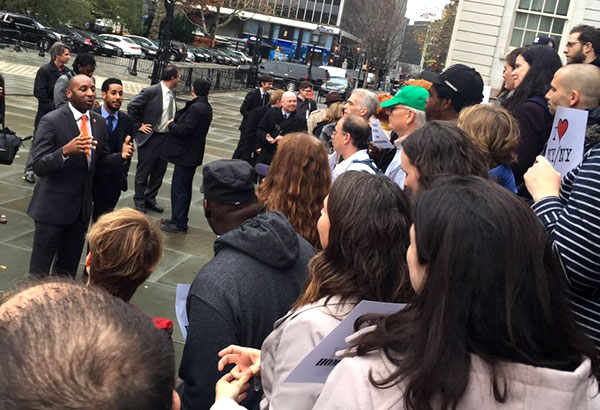
Council Members Richards, left, and Reynoso, the authors, address a crowd
As co-chairs of the New York City Council’s Progressive Caucus, we have worked closely with Mayor de Blasio since he took office. It is clear that the mayor has delivered for our constituents and all 8.4 million New Yorkers in transformative ways. From affordable housing to quality jobs to expanded educational programming, New Yorkers are doing better and the scale of the accomplishments is substantial.
In partnership with our Speaker, Melissa Mark-Viverito, and the City Council, Mayor de Blasio has been helping to create a more equitable New York City. But this progress did not happen by chance, and it’s no foregone conclusion that we will be able to sustain it. We cannot allow our momentum to be derailed, destabilized, or diminished.
Under a boldly progressive mayor and Council speaker, New York is safer and public policy is more equitable than at any point in our lifetimes. We must protect our progress, join us as we launch our #ProtectProgress campaign, which includes the following highlights of this work, the Top 10 Accomplishments, by the Numbers:
1. Making Communities Safer: With two consecutive years of record low violent crime statistics, New York is the safest big city in the country.
2. Making Pre-K Universal: More than 68,500 children are getting the head start they deserve this year with full day pre-kindergarten classes for all of New York’s four-year-olds.
3. Developing and Preserving Affordable Housing: Over 100,000 New Yorkers have access to 40,000-plus new units of affordable housing. More affordable housing units were created in 2015 than in any year since the city’s housing department began.
4. Creating Economic Growth: More New York City jobs than ever before, totaling 4,296,100 across all five boroughs as of March 2016. This includes 254,900 new private sector jobs created during this administration, resulting in an unemployment rate of 6.1%, lower than other large cities like Chicago, Los Angeles, and Philadelphia. This is in part due to new legislation preventing discrimination against job seekers based on credit scores and prior convictions.
5. Improving Police-Community Relations: Reducing unlawful stop-and-frisks, which disproportionately affect African-American & Latino New Yorkers with a 97% decline over four years.
6. Expanding Learning Time: The Mayor’s universal after-school program for 113,874 middle school students (double the number previously served) is providing quality programming during a critical time for childhood development.
7. Embracing Immigrant Communities: IDNYC enables non-citizens to participate in the civic and cultural life of the city, with 855,000-plus cardholders who have secured the peace of mind that comes from recognized government identification.
8. Extending New Yorkers’ Legal Right to Sick Leave: 3,400,000 private and nonprofit sector workers have access to paid sick leave thanks to an expansion created in partnership with the Council and the Mayor’s robust education campaign.
9. Making Streets Safer through Vision Zero: In 2015, New York City saw the fewest traffic fatalities in history, with a 22% reduction resulting from reduced speed limits and comprehensive safety plans.
10. Supporting a Living Wage: A $15 living wage is now guaranteed to every City worker and employee of nonprofit organizations contracted with the City, and the Mayor and Council have advocated for higher wages for all workers across the state.
We must be proud of these accomplishments while we also build on them. Today, we call on progressives from Bushwick to Harlem, from the Rockaways to Riverdale to step and up and #ProtectProgress. Parents: tweet from your UPK sites that didn’t exist two years ago! Bicyclists: tweet images of your new protected lanes that are helping to save lives! IDNYC cardholders: tweet from wherever you are putting your card to use!
Let’s get #ProtectProgress into the conversation, so that together we can promote real results that Mayor de Blasio and the City Council have delivered for New Yorkers.
***
City Council Members Antonio Reynoso and Donovan Richards are co-chairs of the Council’s Progressive Caucus. On Twitter @DRichards13 & @CMReynoso34.
***
Have an op-ed idea or submission for Gotham Gazette? Email This email address is being protected from spambots. You need JavaScript enabled to view it.
An Office of Civil Rights for New York Education
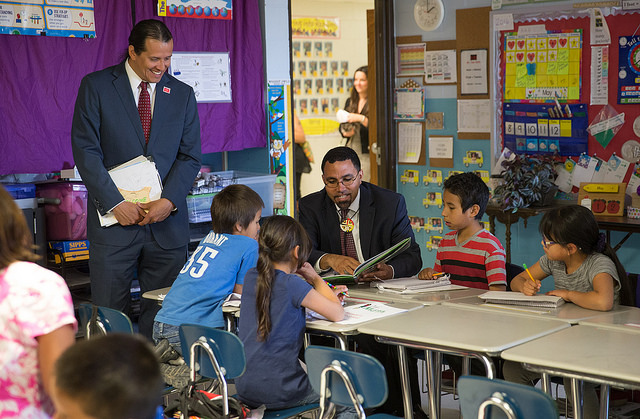
U.S. Education Secretary John King (photo via USDOE on flickr)
Educational civil rights in New York are once again front and center.
The Civil Rights Project at UCLA calls New York City the most segregated school district in the country.
Journalist Nikole Hannah-Jones in her award winning This American Life podcast, "The Problem We All Live With," documented the toxic racism embedded in Americans’ assumption of school district autonomy, no less a problem here.
In "School Money: The Cost of Opportunity," NPR similarly reported in detail how district property taxes stoke profound inequities in school spending, long identified as a key issue in New York.
All students should have the opportunity to attend integrated, well-resourced schools. Yet, instead of our leaders saying "the buck stops here" and meaning it, today's dime-store impostors continually pass the buck to those least able to tackle this crisis.
Ex-New York State Education Commissioner, now Secretary of Education John King is reported saying "local policymakers are the ones with the real power to integrate schools."
New New York Regents Chancellor Betty Rosa announced last week, regarding desegregation, that “I believe this is one that has to be done at the local level versus being mandated."
Most memorably, New York City Schools Chancellor Carmen Farina argued that desegregation should occur "organically" and more recently said not she, but community district superintendents and principals, should engage local real estate agents to solve the problem. "One of the things I’ve recommended to superintendents is have breakfast with your real estate agent, particularly the real-estate agents in the new developments going up,” she said at a community forum where she also suggested better school public relations might be a useful tool.
Huh?
That these officials are a black male and two Latinas may mean civil rights don’t matter anymore. But the research cited by UCLA, Hannah-Jones, NPR, and other sources says otherwise. In yet another study on the long term effects of desegregation and school quality announced last Wednesday, researchers found court-ordered school desegregation did not affect outcomes for whites, it significantly improved the adult attainment of blacks born between 1950 and 1975.
King, Rosa, and Farina -- and their respective partners in perpetuating segregation: President Barack Obama, State Education Commissioner MaryEllen Elia, and Mayor Bill de Blasio -- seem to accept this in their statements. Civil rights do matter. They just don't want to tackle it. Too hot to handle.
But we in New York have an urgent need to face this problem and it won't be solved "organically" because it wasn't created organically. Segregation by race and class is baked into our atomized system of over 700 state school districts and the city's community school districts. Our schools are hard-wired for segregation. Our political system then doubles down on this geographic inequity by imposing an educational finance system that rewards haves over have nots.
No less than a complete upheaval of American public education will change these facts and their unacceptable consequences. But an important if partial fix is available to New Yorkers, modeled on the federal Office of Civil Rights. OCR, part of the U.S. Education Department with enforcement ties to the Department of Justice, takes citizen complaints and embarks on its own investigations to remedy individual instances of inequity. New York's State Education Department should create such an office, tied to the enforcement arm of the state Attorney General.
This won’t solve our overall problem of segregation and inequity. But we need to take the denial of educational civil rights out of the hands of political cowards and create an agency the mission of which is to correct these wrongs. And in so doing we will attack the overall problem bit by bit. Black, Latino, and low-income students need this help. Asian students need this help. Special needs students need this help. Orthodox Jewish students need this help.
We all need this help.
***
David C. Bloomfield is Professor of Education Leadership, Law, and Policy at Brooklyn College and The CUNY Graduate Center. The third edition of his book, American Public Education Law, will be published this summer. He is on Twitter @BloomfieldDavid.
***
Have an op-ed idea or submission for Gotham Gazette? Email This email address is being protected from spambots. You need JavaScript enabled to view it.
NYPD 'Peace Dividend' Reveals Truth About Unnecessary Arrests
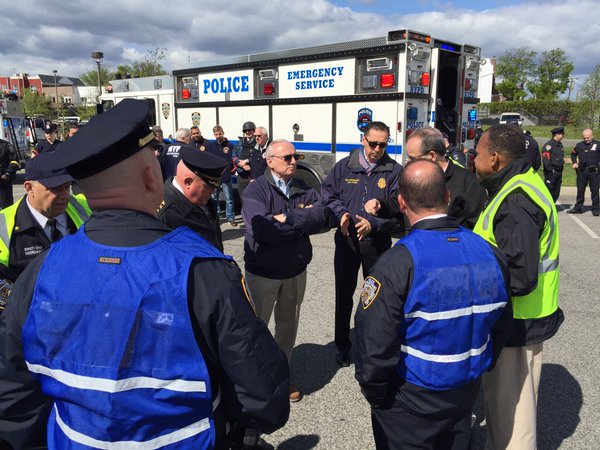
Commissioner Bratton and others (photo via @NYPDnews)
Last May, NYPD Commissioner Bill Bratton issued a 41-page report extolling the virtues of Broken Windows and quality-of-life policing, and promoted what he termed a “peace dividend” of “nearly a million fewer enforcement contacts like arrests, summonses, and reasonable-suspicion stops when compared to their respective highs.” He explained further in a letter to City Council Speaker Mark-Viverito: “there has been a drastic reduction in enforcement contacts between police and citizens, a benefit of lower crime that I call the Peace Dividend.” He clarified that the “dividend” is the “diminished need to use enforcement tools for every problem."
The use of the phrase “peace dividend” is telling and alarming. The term was frequently used at the end of the Cold War when many nations cut their military spending and money originally intended for the military became available for other purposes. No doubt while the Commissioner was fighting his war on crime, the police felt like an occupying army to black and Hispanic people living in neighborhoods that bore the brunt of a policy of massive arrests for trivial things.
While the commissioner’s notion of a dividend does not seem to correspond to additional government funds allotted to badly needed social programs in the affected communities, it does at least mean that more people in those same communities might be left in peace. On the other hand, Bratton’s pronouncement is redolent of an omnipotent overlord magnanimously bestowing a gift upon the residents of neighborhoods like South Jamaica, Brownsville, Mott Haven, and East Harlem, where rampant arrests and summonses have created immeasurable alienation, damage, and suffering.
Recently, in the course of another round-up of crime statistics, Commissioner Bratton noted that arrests were down by about 10 percent in April. In an effort to explain the drop, he said that the police were making fewer arrests for minor offenses and that “[w]e are trying to reduce the number of contacts we have with the public that [are] not necessary.”
On its face, continued evidence of the so-called peace dividend is laudable. Decreasing unnecessary police-citizen interactions is obviously a worthy goal. But upon closer inspection, the commissioner’s explanation is troubling and revealing.
Shouldn’t he try to eliminate, rather than reduce, unnecessary police-citizen contact? While the commissioner’s acknowledgement that some number of police-citizen contacts is unnecessary is notable for its candor, it is also disturbing for its veracity – it begs the questions of just how many unwarranted interactions there are and upon whom are they inflicted. Answering these questions is not easy, but is essential.
Former Mayor Michael Bloomberg and his police commissioner, Ray Kelly, repeatedly and defiantly argued that the ever-rising number of stops-and-frisks – that peaked at almost 700,000 in one year (2011) – were necessary for public safety. When a federal judge ruled that the stops were unconstitutional, Bloomberg excoriated the judge saying, "[T]his is a very dangerous decision made by a judge who I believe does not understand what good policing is."
To drive his point home, he observed that he was glad that the implementation would likely take place after the end of his term, saying, "I wouldn’t want to be responsible for a lot of people dying." Well, crime continues to decline even as the number of recorded stop-and-frisks has plummeted to a current estimate of 25,000-35,000 for 2016 (a drop of around 95 percent from the high), providing powerful evidence that hundreds of thousands of stops were unnecessary, as well as illegal.
In similar fashion, the 10 percent reduction in misdemeanor arrests has not corresponded to an uptick in crime, suggesting that perhaps the ‘peace dividend’ is being miserly applied. Why not 15 or even 25 percent? Why not try a pilot program in some precincts to see how far the dividend could go? The NYPD issues about 1,000 summonses each year for riding a bike on the sidewalk in East New York. What if the officers in that precinct were instructed not to issue any summonses for unlawful bike-riding for some period of time? If crime did not correspondingly increase, the same approach could be taken with similar low-level offenses in that and other precincts, and the number of unnecessary police contacts with the public could be further reduced.
The awareness of necessary versus unnecessary contacts even runs through the NYPD rank and file. Back in December 2014 and into early 2015, police officers engaged in a slowdown to express unhappiness with Mayor de Blasio’s handling of Eric Garner’s death at the hands of Police Officer Daniel Pantaleo and the killings of Police Officers Wenjian Liu and Rafael Ramos. An email, widely believed to be from the Patrolmen’s Benevolent Association, was circulated instructing officers to make arrests only when it was “absolutely necessary.” Arrest numbers dropped precipitously over the next few weeks leading to the recognition that the NYPD’s standard operating procedure included an awful lot of unnecessary arrests. Consider as well that the crime rate continued to drop even in the face of drastically reduced arrests, tickets and stops.
Hyper-aggressive policing tactics like stop-and-frisk and Broken Windows enforcement drove the number of unnecessary police contacts with the public into the millions. More specifically, it did indeed amount to a war waged in and upon communities of color. Commissioner Bratton’s peace dividend has a long way to go to rectify that reality.
***
Steven Zeidman is a professor of law at CUNY School of Law. He is on Twitter @SteveZeidman.
***
Have an op-ed idea or submission for Gotham Gazette? Email This email address is being protected from spambots. You need JavaScript enabled to view it.
Clarity on the City's Investment in Health + Hospitals
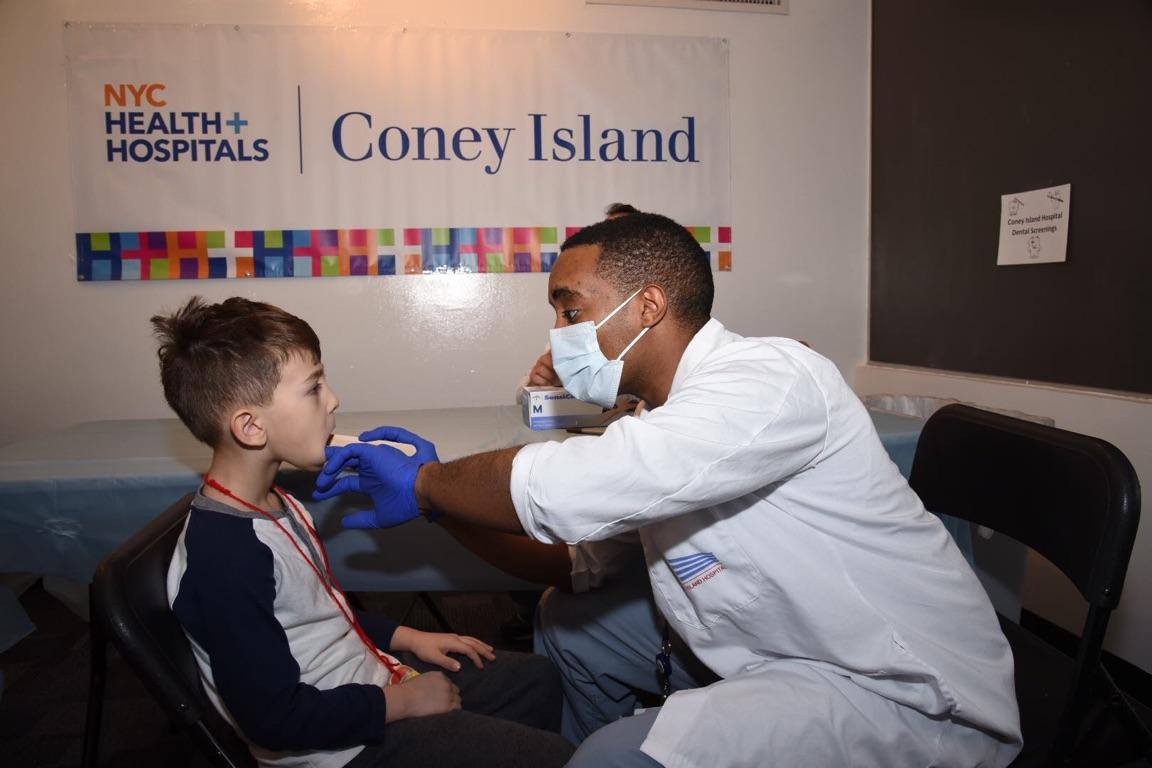
(photo via Health + Hospitals on Facebook)
New York City Health + Hospitals is a model public system, the country’s oldest and largest commitment to safety-net health care. Yet Mayor Bill de Blasio’s recent plan to shore up finances at Health + Hospitals has led to consternation from those who would have us believe that H+H is an oversized and outdated system.
In a recent New York Daily News column, Errol Louis made this argument while saying that the burden of undocumented immigrants is a key flaw in Health + Hospitals’ current structure. Misunderstandings and misrepresentations of this structure and Health + Hospitals’ role in today’s health care landscape and within the city budget are, unfortunately, becoming more widespread.
Concerns about the financial standing of such a critical community institution are merited. The solution, however, is to promote policies that support quality, cost-effective care at Health + Hospitals, starting with Mayor de Blasio’s budget proposal.
The suggestion that H+H is unable to keep up with the health care system’s changing tide away from hospital-based care and toward preventive, community-based services overlooks the fact that Health + Hospitals is already providing comprehensive and culturally competent services across the care spectrum, from primary care in more than 30 community healthcare centers and 25 school-based health centers, to its better-known network of 11 hospitals providing acute and ambulatory care.
H+H has a diverse staff that represents the culturally and linguistically diverse communities it serves. In recent years H+H has responded to almost 700,000 patient requests for interpreter services.
In his column, Mr. Louis cites a 2014 report that one-quarter of hospital admissions are avoidable. He is right, but this is a problem of health care in general, not of NYC Health + Hospitals specifically. New York State’s Delivery System Reform Incentive Payment (DSRIP) Program is currently providing health systems across the state $8 billion in incentive payments to better coordinate care and reduce avoidable hospitalizations by 25% by 2020. The largest of the state’s 25 DSRIP systems is spearheaded by none other than Health + Hospitals. Whether DSRIP is successful remains to be seen, but there is no doubt that Health + Hospitals is at the forefront of system change.
As a public network, Health + Hospitals provides care to anyone who needs it, regardless of ability to pay or immigration status. It is an important provider of care to the city’s 375,000 undocumented immigrants, who face daunting restrictions in access to both public and private insurance. Mr. Louis uses this fact to support his unfounded claim that undocumented immigrants crowd emergency rooms because they have nowhere else to go for their basic health needs.
The truth, demonstrated in rigorous public health studies, is that undocumented immigrants use health care services, including emergency rooms, at lower rates than U.S. citizens and other immigrants. Because Health + Hospitals provides comprehensive and coordinated services, undocumented immigrants do indeed use the public (read: primary care) system for “routine health needs,” as Mr. Louis says – exactly as they should.
Contributions to the tax base should not be a prerequisite for receiving health care in a modern, humane society, but it is worth noting that undocumented immigrants in New York state, about 70 percent of whom live in New York City, contributed $1.1 billion to the state’s economy in 2012, according to the Institute on Taxation & Economic Policy. They are hardly free-riders.
In the true spirit of the safety net, Health + Hospitals provides care for uninsured patients, citizens and immigrants alike, without being reimbursed for it. This is a fundamental problem for the system’s finances. The solution is not to reconsider the mission of Health + Hospitals but to support policies that reduce unreimbursed care by promoting federal and state funding for health systems and increasing access to health coverage for those who remain uninsured. These are real, meaningful steps to ensure that health care providers are adequately reimbursed for services.
Mr. Louis casts the financial needs of the city’s public health system as a threat to education, transportation, and housing. Pitting public services against one another in this way is unfair and does not recognize that preservation of health is the foundation upon which New Yorkers take advantage of educational opportunity and lead rewarding, productive lives.
A city that abandons its obligation to fill the gaps in the frayed federal and state health care safety net does itself and its residents a disservice. New York City doesn’t need a smaller or less generous public Health + Hospitals system; it needs a system that is recognized for the value it provides to our communities and that is supported accordingly.
***
Max Hadler is the health advocacy specialist for the New York Immigration Coalition. On Twitter @theNYIC.
***
Have an op-ed idea or submission for Gotham Gazette? Email This email address is being protected from spambots. You need JavaScript enabled to view it.
Passing the Buck on Affordable Housing
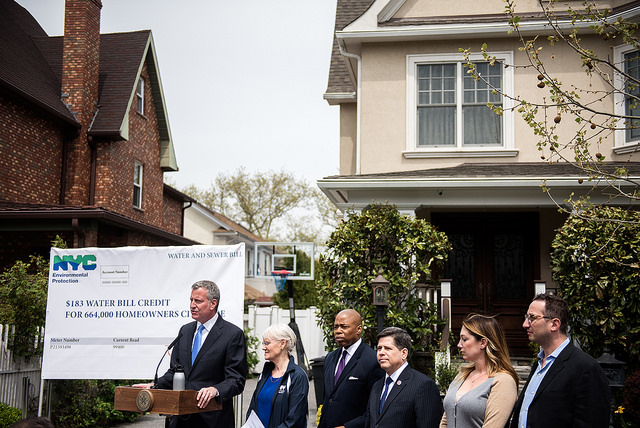
Mayor de Blasio makes an announcement (photo: Demetrius Freeman/Mayor's Office)
Passing the buck is one thing. Passing seventy million bucks is quite another.
Each year, New York City sells between $70 million and $120 million in unpaid tax debt, water charges, and emergency repair loans to a private trust. These liens—which enable the owner to foreclose on the property—then increase rapidly in value. The trust can charge nine percent interest on 1-3 family houses and 18 percent interest on multifamily housing, compounded daily.
Yes, daily. Total tax debt can triple or even quintuple in a year.
For homeowners who fall behind on their taxes and cannot enter into a payment plan with the City, being put into the tax lien sale means shooting down a steep waterslide into a deep pool of debt. Predatory lenders and equity firms often prey on them as they either try to hang onto their property or sell it for as much equity as they can possibly keep. Sometimes even being on the tax-lien sale list can lead to foreclosure by a lender.
For tenants in buildings in the tax lien sale, times can be just as hard or worse. Landlords tend to pay their taxes even if they withdraw services from a building: they want to hang on to their property. But when they stop paying taxes and end up in the lien sale, it’s often a sign that the building is already in deep trouble. Being in the lien sale doesn’t make it better. Under pressure to sell, landlords often try to harass tenants out because empty buildings sell for more than full ones.
Nonprofit organizations such as churches, daycare centers, and community gardens also find their property in the lien sale in spite of the fact that their property should be exempt from local taxes. The tax lien sale can wipe out years of tax benefits that add up to public investment in these organizations if, for reasons of age, illness, death, or simple ignorance of, or inability to navigate the Department of Finance’s new online system to renew their tax exemptions, they fail to do so in time.
Meanwhile, the city is dealing with an unprecedented homelessness crisis, an affordable housing shortage, and—by its own lights—a dearth of land and property with which to help solve these problems. And yet, at the same time, for the last twenty years, it has given up its own power to foreclose on much of this property and to preserve it for affordable housing and to meet other community needs in favor of selling this right to a bank-managed, private trust.
This wasn’t always the case. Before Mayor Giuliani instituted the tax lien sale in 1996, the City did foreclose on tax-delinquent housing. It wasn’t always a pretty story. The City managed much of this housing poorly. But beginning in 1986, under Mayor Koch, it used a lot of this foreclosed property to create over 250,000 units of housing. Much of this is the only truly affordable housing for poor people in the city apart from public housing.
With this year’s tax lien sale on Thursday, May 12, the time for reform is now, so that this year’s is the last of its kind.
The City doesn’t have to go back to the bad old days of owning thousands of units of foreclosed housing. It could divert the majority of the more than 4,000 properties a year from the lien sale and make huge strides toward meeting Mayor de Blasio’s goal of preserving or creating 200,000 units of affordable housing.
Through regulatory agreements that subordinate tax debt to permanent affordability requirements, and foreclosure and disposition to nonprofits like community land trusts and mutual housing associations (much like large, low-income cooperatives), the City can put financially shaky housing on new footing by realizing economies of scale in purchasing and management. It can preserve nonprofit assets and the public investment that went into them, and it can even turn vacant lots into affordable housing opportunities. By keeping these properties out of the lien sale, it can keep them from becoming prohibitively expensive to save.
Would it cost money? Of course. But so does passing the buck for New York’s housing crisis to generations to come.
***
John Krinsky is an associate professor in the Department of Political Science at The City College of New York and a board member of the New York City Community Land Initiative.
***
Have an op-ed idea or submission for Gotham Gazette? Email This email address is being protected from spambots. You need JavaScript enabled to view it.




